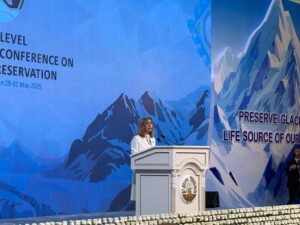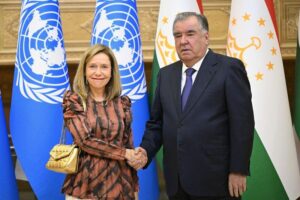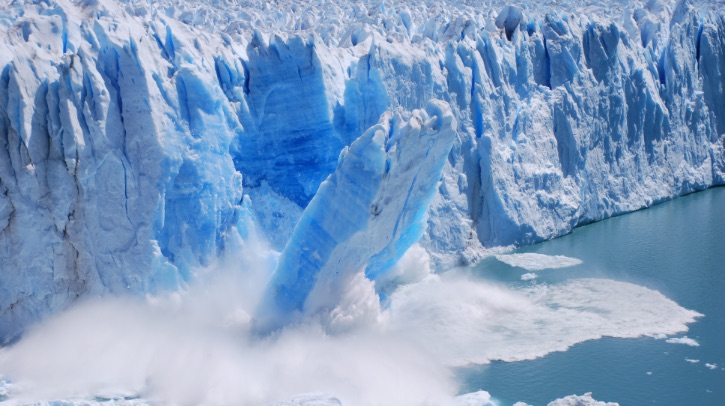Tajikistan has hosted the International Conference on Glaciers’ Preservation to highlight the urgent need to halt glacial retreat and raise it to the top of the global climate agenda.
The World Meteorological Organization (WMO), Asian Development Bank and UNESCO partnered to organize the conference, which was attended by government leaders and ministers, as well as UN deputy secretary-general Amina Mohammed. The three-day conference brought together government leaders, heads of international agencies, glacier experts, policymakers and climate leaders from around the world.
Key topics of discussion included glacier preservation, water cooperation, the role of cryosphere monitoring in water allocation, sea-level rise and transboundary collaboration. Other sessions explored scientific monitoring, the socio-economic impact of glacier melt and strategies to catalyze action through global frameworks and partnerships.
“Glacier preservation is not just a problem of countries with glaciers but rather a global crisis that deserves the immediate attention of the international community,” said Tajikistan’s president, Emomali Rahmon, in an opening address.
The conference culminated in the release of the Dushanbe Glaciers Declaration – a landmark document outlining actionable commitments, collaborative initiatives and strategic recommendations to be presented at the UN Climate Change conference, COP30, in Brazil.
“The World Meteorological Organization’s State of the Global Climate 2024 Report highlights that 2021-2024 represents the most negative three-year glacier mass balance period on record, and seven of the 10 most negative annual glacier mass balances since 1950 have occurred since 2016,” said Amina Mohammed.
She cited figures from the World Glacier Monitoring Service that reveal that since 1975, glaciers have lost more than 9,000 billion tons, which is equivalent to a 25m-thick ice block the size of Germany. She also highlighted that there are more than 275,000 glaciers worldwide, covering approximately 700,000km², and that ice sheets and glaciers store about 70% of the world’s freshwater resources.
“Our glaciers are dying,” said WMO secretary-general Celeste Saulo. “Nepal recently declared the loss of Langtang’s Yala Glacier. Venezuela has become the second country in the world after Slovenia to lose all its glaciers. The death of a glacier means much more than the loss of ice. It is a mortal blow to our ecosystems, economies and social fabric.”

Bridge science and services
Saulo emphasized that glacier monitoring, research and related services in high mountain and polar regions are critical priorities for WMO, as observing, predicting and effectively communicating glacier changes are vital to mitigating their impacts on people, economies and ecosystems.
“We need to strengthen glacier monitoring and protection through models and observations,” she said. “We need more data sharing and more political will. We need to bridge science and services and forecasts and action.”
Glacier research
A 2023 report titled Water, Ice, Society and Ecosystems in the Hindu Kush Himalaya by the International Centre for Integrated Mountain Development (ICIMOD) predicted that the Hindu Kush Himalaya could lose up to two-thirds of its glaciers by the end of the century. In Tajikistan, around 30% of glaciers have disappeared over the last century.

The Vanj yakh (former Fedchenko) Glacier, the world’s largest continental glacier, has retreated by over 1km in the past 70-80 years and shrunk by 44km², which is the equivalent of 6.4 million Olympic swimming pools and 6,000 football fields worth of ice.
As a result, Brazil’s Amazon, fed by Andean glaciers, is in severe drought, and extreme events from rapid snowmelt, glacier outburst floods and landslides have hit countries from Germany to Peru to Nepal. Glacier melt has already contributed an estimated 18mm to sea-level rise, posing a major risk for coastal areas.
Audrey Azoulay, director-general of UNESCO, stated, “In 2022, a UNESCO study highlighted that the glaciers in one-third of these world heritage sites are projected to disappear by 2050 – a stark reminder of the need for bold and immediate climate action. At UNESCO, we are committed to glacier preservation, with glaciers present in over 120 UNESCO-designated sites, including biosphere reserves, global geoparks and world heritage sites.”
“Melting glaciers threaten lives on an unprecedented scale – including the livelihoods of more than two billion people in Asia alone,” said Yingming Yang, vice president of the Asian Development Bank. “As a trusted partner, ADB is committed to helping Asia and the Pacific tackle this most complex of challenges, with adaptation investments and an enduring commitment to continue helping our region swap fossil fuels for clean energy in a way that does not compromise energy access or economic development.”



